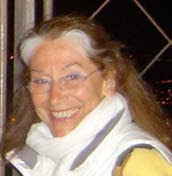 by Madeleine Kando
by Madeleine Kando
I went down memory lane again during my most recent visit to Amsterdam. I like to stroll down the old familiar streets, inhaling the smell of a cosmopolitan city and generally enjoying my brief visit to the town I grew up in.
My favorite pass-time is to walk through the old neighborhood, peek through the windows of the house I used to live in. I like that ritual. This time, however, my visit took on an added dimension. This time I got caught up in the city-wide effort to honor the Jews who were taken from their homes by the Nazis.
So here I was, together with my Dutch friend Edith who lost her entire family in the holocaust. She took me by the hand on this incredible journey, like a good teacher does with a student and we followed the trail of the thousands of Jews who were taken from their homes and herded to the Station to be shoved onto the cattle trains that were going to the concentration camps.
We first went to the house where her parents met and fell in love. It was one of those amazingly quiet side-streets that makes you wonder where the city has disappeared to, together with all the traffic noise. We looked up at the windows where her mother and four aunts had lived. Her aunts were taken from that house and sent to Auschwitz. We rang the bell but there was no-one at home. What did the aunts feel when a Nazi soldier rang this same bell on an equally quiet day in 1942? Did they know what was in store for them? We continued on to our next stop, the Achtergracht.
It’s a cute ginger bread-like house with only one room on each floor. As I stand there I realize that the house speaks silently to me of all the tragedies that it has witnessed, the many lives that it has harbored, one of which was mine as a young girl. The paper in my hand says that a ‘Mozes Frank’ lived here. He was married to Eva Frank. He was taken from this house by the Nazi's in 1942.
Did he sleep in my old room? Did he wake up and look out, like I did onto the barges where men covered with soot were carrying off sacks filled with coal? Did he walk on the cold wooden floor to the little bathroom and had to sit sideways because the space was so small? Did he go down the three flights of steep stairs to make coffee in the tiny little kitchen? Why was he taken from this amazing house instead of me? What if I had lived there in 1942 instead of him? Why wasn't I born yet and he was?
Tomorrow, on May 4th, thousands of Amsterdam residents will put a poster in their window to mark their house if a former Jewish resident was arrested or deported to Nazi death camps during World War II.
This poster idea is the initiative of Frits Rijksbaron, a marketing executive who hopes to remind Amsterdam's citizens how different Amsterdam would have been had 61,700 Jews not been removed from their city.
More than seventy percent of Dutch Jews were killed by the Nazis. Children, babies, grandmothers, fathers and mothers. I am on the Dutch ‘Jewish Homes’ website staring at the list of thousands of addresses. Every address has one, two, five names.. All gone, wiped out, removed. The sheer number boggles the mind. It’s true that Holland deported the highest proportion of Jews of all of Nazi-occupied Western European countries. The Dutch are still trying to figure out how that happened.
Now I am back in Boston, writing and watching the morning break outside my window. My little ranch house here in Boston doesn’t have that much of a history. It is ignorant of so much suffering. Too young and unbranded. It might not make it to a ripe old age anyway because, unlike my house on the Achtergracht, it wasn’t built to last. But if houses could speak I am sure everyone of them would want to tell a story. leave comment here
Youtube
Contact Form
Popular Posts
-
By Madeleine Kando Flying is like signing away your rights as a human being. Not only is your life put on hold, but you never know which sid...
-
By Tom Kando Only one thing aggravates me more than the mistakes of the electorate - as exemplified by the Democratic loss in Massachusett...
-
by Madeleine Kando We left Boston early Sunday morning, the day before the 2024 Solar Eclipse. We have friends who live close to the Canadia...
-
Tom Kando Some societies are more successful than others. Today, there are successful societies such as Australia, Canada and Scandinavia,...
Tom's Publications and Essays
Madeleine's Publications and Essays
interesting links
Publish Your Article!
A valid author name is required. We will create live links to url's that you specify in your post. Please be patient, and allow us some time to read and approve your article.We reserve the right to refuse any articles that are not deemed appropriate for this blog.








